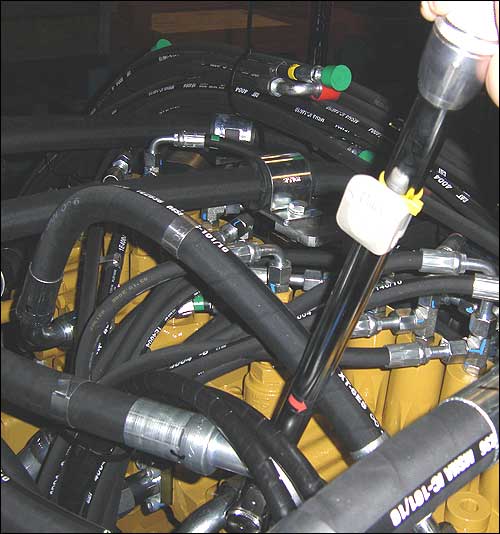May 06, 2009Caterpillar is employing a real-time location system (RTLS) at its heavy-equipment manufacturing plant in Belgium to ensure its hydraulic valves and hoses are assembled properly. When the company assembles its hydraulic valves at its plant in the Belgian city of Gosselies, it uses torque wrenches to fasten reinforced tube hoses—made of rubber and steel—to those valves. The valves, installed in the construction vehicles Caterpillar manufactures, are approximately the size of a car engine. When tightening a bolt that fastens a hose to a valve, a worker must apply a specific amount of torque—around 300 Newton meters (Nm)—in order for that valve to operate properly. Until recently, that tightness was adjusted using a manual torque wrench, and employees had to be trusted to apply the proper amount of Newton meters.
For its assembly process, Caterpillar utilizes a software system known as Protrac, provided by Belgian industrial software firm De Jaeger Automation, to track each part's assembly, as well as who assembled it, and when. The software, running on PCs installed at assembly locations, enables a staff member to input his identification number and key in details such as the type of work he is about to conduct, and the serial numbers of the components he plans to assemble.

Prior to Caterpillar's adoption of RFID, however, the tightness of the hose installation depended on the employee's judgment, with that person simply marking the parts with paint to help gauge the connection's tightness. Therefore, the company had sought a system that would reduce the number of hose-tightening errors, while also making it simpler for staff members to apply the appropriate amount of torque during the assembly process.
The plant, which employs approximately 4,300 workers, builds medium- and large-sized excavators and wheel-loaders. Caterpillar met with De Jaeger in 2008, says Benoit Degraux, Caterpillar's project director, and together the two firms developed an RFID-based system within the necessary price range.
The amount of torque is crucial, Degraux says, because if those hydraulic hoses are not properly tightened, failure could result in leaking valves when the complete machine is assembled and tested prior to shipping for retail sale. "The main target of implementing traceability on this zone was to ensure that the correct number of tightenings are applied to the valve," he states. The company needed to know not only whether the proper tightness was employed, but also that the right tool (preset to tighten a specific amount) was used in the correct location.
Today, compact Ubisense tags are mounted on the torque wrenches. Each battery-powered 7 GHz ultra-wideband (UWB) tag transmits a unique ID number only when in motion, and goes to sleep when immobile, in order to conserve battery life. Eight Ubisense interrogators are mounted on the ceiling, each tuned to read tags in an area measuring 6 meters by 30 meters (19.7 feet by 98.4 feet). The readers cover six production positions, capturing the unique tag ID of the wrench each worker uses, then sending that ID number to Caterpillar's back-end system, as well as to PCs at the six stations at which the valves are assembled. The Protrac software determines whether the correct wrench is being operated in the proper location, based on that tool's calculated location.
Before beginning to assemble a valve, a worker inputs his or her ID number, which is linked to employee-related data, including which assembly that individual is authorized to work on. The worker then uses a bar-code scanner attached to the PC in his or her work area to scan the ID number on the machine part. The system links that bar-code number with the location and identity of the torque wrench the employee begins using, to ensure the correct wrench is in the appropriate location for the work about to be completed. The screen then displays instructions regarding the procedures that should be undertaken, as well as an alert if the wrong tool is in the work station. The color green indicates the correct wrench is being operated in the proper zone, while yellow means the tool is not at the correct assembly station and red signifies the worker's PC has lost its network connection with the back-end server.
The results, thus far, have been positive, Degraux says. The majority of hydraulic valves and hoses are now being found to be properly assembled when tested—a higher accuracy rate than the company had experienced in the past—and that has led to less rework on leaking valves discovered during the testing process.

